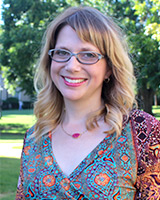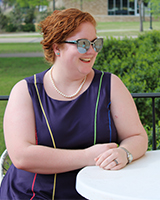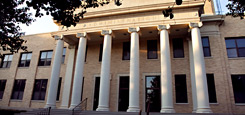 Austin College President Steven P. O’Day and the senior leadership team, like their counterparts at colleges across the nation, made the decision to begin remote instruction in mid-March as COVID-19 restrictions limited gatherings and government officials urged citizens to remain at home. At Austin College, close interaction with faculty and peers is foundational to the student learning tradition. The decision to “go remote”—though inevitable—brought a central question: could remote learning really work for Austin College students and faculty?
Austin College President Steven P. O’Day and the senior leadership team, like their counterparts at colleges across the nation, made the decision to begin remote instruction in mid-March as COVID-19 restrictions limited gatherings and government officials urged citizens to remain at home. At Austin College, close interaction with faculty and peers is foundational to the student learning tradition. The decision to “go remote”—though inevitable—brought a central question: could remote learning really work for Austin College students and faculty?
As March gives way to April, general opinion seems to be “yes, but” as some elements of the process may be less than ideal. Of course, much about daily life is less than ideal in these times.
 Dr. Beth Gill, vice president for Academic Affairs, is quick to give credit to the Austin College community for a tremendous effort. “I am incredibly proud of our students and faculty,” said Gill. “This experience is a life lesson in sheer grit and determination. I have been so impressed to hear of the diligence of faculty and students alike to make class sessions happen. Too, our remarkable IT staff members, led by director Garrett Hubbard, have been on call 24/7 since this all began—and made this entire transition possible. They worked closely with our faculty to prepare hardware, software, and platforms to make the launch of class meetings online not only possible but successful. Now, they are following up with students to address needs on a one-on-one basis. Though IT work is somewhat behind-the-scenes, everyone should understand we couldn’t have reached this achievement in remote learning without them.”
Dr. Beth Gill, vice president for Academic Affairs, is quick to give credit to the Austin College community for a tremendous effort. “I am incredibly proud of our students and faculty,” said Gill. “This experience is a life lesson in sheer grit and determination. I have been so impressed to hear of the diligence of faculty and students alike to make class sessions happen. Too, our remarkable IT staff members, led by director Garrett Hubbard, have been on call 24/7 since this all began—and made this entire transition possible. They worked closely with our faculty to prepare hardware, software, and platforms to make the launch of class meetings online not only possible but successful. Now, they are following up with students to address needs on a one-on-one basis. Though IT work is somewhat behind-the-scenes, everyone should understand we couldn’t have reached this achievement in remote learning without them.”
TOGETHER, AT A DISTANCE
 Using Zoom and other technology, faculty and students can communicate in real time, together, though physical distance and technological limits remain drawbacks. Dr. Patrick Duffey, professor of Spanish, said he counts on looking in his students’ faces to gauge how much they understand in his language class, and he’s unable to do that now. But, he has been surprised how his Spanish 101 students are able to partner up and perform live one-minute skits in front of the class. “Granted, students are acting their parts in Spanish from different locations for an audience that is also in 27 different locations,” Duffey said. “But that has actually made the activity more fun.”
Using Zoom and other technology, faculty and students can communicate in real time, together, though physical distance and technological limits remain drawbacks. Dr. Patrick Duffey, professor of Spanish, said he counts on looking in his students’ faces to gauge how much they understand in his language class, and he’s unable to do that now. But, he has been surprised how his Spanish 101 students are able to partner up and perform live one-minute skits in front of the class. “Granted, students are acting their parts in Spanish from different locations for an audience that is also in 27 different locations,” Duffey said. “But that has actually made the activity more fun.”
 Dr. Brian Watkins, assistant professor of anthropology, also regrets missing out on some of the nonverbal communication he normally deems necessary for teaching, but he said that student Zoom discussions have been reminiscent of the actual classroom.
Dr. Brian Watkins, assistant professor of anthropology, also regrets missing out on some of the nonverbal communication he normally deems necessary for teaching, but he said that student Zoom discussions have been reminiscent of the actual classroom.
 In addition to main Zoom class sessions, Dr. Mindy Landeck, assistant professor of East Asian studies, uses Zoom for small group sessions in which two or three students meet together. She connects with those groups individually to identify what help students may need most.
In addition to main Zoom class sessions, Dr. Mindy Landeck, assistant professor of East Asian studies, uses Zoom for small group sessions in which two or three students meet together. She connects with those groups individually to identify what help students may need most.
 Sophomore Alex Anderson of Dallas finds that the Zoom platform—through which she takes four courses—preserves some sense of community since consistent personal contact does occur. She admits, though, that she doesn’t “necessarily enter Zoom sessions with the normal excitement I would carry into a traditional, in-person classroom environment,” she said. She does see the Zoom classes as a good alternative considering the situation.
Sophomore Alex Anderson of Dallas finds that the Zoom platform—through which she takes four courses—preserves some sense of community since consistent personal contact does occur. She admits, though, that she doesn’t “necessarily enter Zoom sessions with the normal excitement I would carry into a traditional, in-person classroom environment,” she said. She does see the Zoom classes as a good alternative considering the situation.
 Some limitations, however, can arise in math and science courses. Sophomore “Vee” Kalkunte, at home in Frisco, Texas, said overall her classes are going well. “For the most part, our projects translated well, with Zoom team meetings and essay help over Google Drive,” she said. “One huge struggle has been math. It’s hard to write it properly via a keyboard or even a digital stylus. But we’ve been working around it, and in some ways, it’s made us more creative.”
Some limitations, however, can arise in math and science courses. Sophomore “Vee” Kalkunte, at home in Frisco, Texas, said overall her classes are going well. “For the most part, our projects translated well, with Zoom team meetings and essay help over Google Drive,” she said. “One huge struggle has been math. It’s hard to write it properly via a keyboard or even a digital stylus. But we’ve been working around it, and in some ways, it’s made us more creative.”
 Dr. Lance Barton, professor of biology, uses the “flipped” model of teaching—recording lectures for students to watch and then using the scheduled Zoom session for discussion and questions. That works fairly well in his introductory-level classes, but his other courses are research-based, and students obviously can’t do experiments at home. Barton records himself performing the experiments for methods videos. “I collected all the data, and students still work through the analysis and presentations, but doing labs remotely or virtually is very difficult,” he said, questioning how his students can replicate the skill building that occurs during in-person lab sessions.
Dr. Lance Barton, professor of biology, uses the “flipped” model of teaching—recording lectures for students to watch and then using the scheduled Zoom session for discussion and questions. That works fairly well in his introductory-level classes, but his other courses are research-based, and students obviously can’t do experiments at home. Barton records himself performing the experiments for methods videos. “I collected all the data, and students still work through the analysis and presentations, but doing labs remotely or virtually is very difficult,” he said, questioning how his students can replicate the skill building that occurs during in-person lab sessions.
 Sophomore Morgan Hall said Zoom courses have presented some unique challenges for music classes, but that students and faculty are learning to work around those. Some of her other classes are operating differently than usual, too. She finds remote learning works fairly well, though this experience makes her value her regular classes even more.
Sophomore Morgan Hall said Zoom courses have presented some unique challenges for music classes, but that students and faculty are learning to work around those. Some of her other classes are operating differently than usual, too. She finds remote learning works fairly well, though this experience makes her value her regular classes even more.
 In microeconomics, a “flipped” classroom gives sophomore Charles Pulliam of Houston an experience that he said is similar to being in class on campus. Dr. Kevin Simmons, professor of economics, records lectures on YouTube and uses class time for discussion. Charles said his other classes are going well, and he credits the faculty for making the Zoom sessions go smoothly. “All of my professors have been very helpful and understanding during these crazy times,” he said.
In microeconomics, a “flipped” classroom gives sophomore Charles Pulliam of Houston an experience that he said is similar to being in class on campus. Dr. Kevin Simmons, professor of economics, records lectures on YouTube and uses class time for discussion. Charles said his other classes are going well, and he credits the faculty for making the Zoom sessions go smoothly. “All of my professors have been very helpful and understanding during these crazy times,” he said.
a
IN THIS TOGETHER
 The awareness of “crazy times” gives students and faculty a sense of making it through together. Sophomore Electra Coffman of Fort Worth is staying with a friend in Austin to do her coursework. “I think everyone is doing their best to make this technological change work, so everything—Zoom calls, group meetings, office hours, syllabus shifts—has worked well so far. My professors are offering many, many chances for us to ask questions and are putting in lots of effort to be as accessible as possible.”
The awareness of “crazy times” gives students and faculty a sense of making it through together. Sophomore Electra Coffman of Fort Worth is staying with a friend in Austin to do her coursework. “I think everyone is doing their best to make this technological change work, so everything—Zoom calls, group meetings, office hours, syllabus shifts—has worked well so far. My professors are offering many, many chances for us to ask questions and are putting in lots of effort to be as accessible as possible.”
Because the Austin College faculty cares deeply about the educational process and the learning experiences of students, they are indeed putting in lots of effort. They agree that students are very appreciative. “Not only have students shown tremendous patience with me as I adapt the course to the demands of remote instruction but many of them have reached out to me personally to thank me for my efforts to make things work under challenging circumstances,” Landeck said. “In return, I am striving to be even more present for them in these uncertain times, touching base through personal emails and conversations, and encouraging them to reach out without hesitation.”
 The Robert and Joyce Johnson Center for Faculty Development and Excellence in Teaching has been providing faculty with training and support for the Zoom video conferencing platform and other online teaching tools since the decision to move to remote learning. The center continues weekly faculty development programs and progress updates via Zoom. “I have been impressed, but not at all surprised, by the generosity of our faculty in providing each other with support, ideas, and expertise as we’ve transitioned to remote learning,” said Dr. Randi Tanglen, center director and associate professor of English.
The Robert and Joyce Johnson Center for Faculty Development and Excellence in Teaching has been providing faculty with training and support for the Zoom video conferencing platform and other online teaching tools since the decision to move to remote learning. The center continues weekly faculty development programs and progress updates via Zoom. “I have been impressed, but not at all surprised, by the generosity of our faculty in providing each other with support, ideas, and expertise as we’ve transitioned to remote learning,” said Dr. Randi Tanglen, center director and associate professor of English.
 So, “yes, but.” As first-year student Janet Salazar of Dallas said, “Remote learning keeps everyone safe without sacrificing anyone’s ability to learn in their classes. It just stinks that we don’t have the same ability to interact and connect in the small classroom environment that Austin College provides and that I have grown to love. But I think it’s the best solution while we are in the midst of a pandemic.”
So, “yes, but.” As first-year student Janet Salazar of Dallas said, “Remote learning keeps everyone safe without sacrificing anyone’s ability to learn in their classes. It just stinks that we don’t have the same ability to interact and connect in the small classroom environment that Austin College provides and that I have grown to love. But I think it’s the best solution while we are in the midst of a pandemic.”
Ah, yes. The pandemic.
UNDERLYING STRESS
Home for Morgan Hall is Round Rock, Texas, but she has a job in Sherman so is living in Bryan Apartments on campus. She said the campus is somewhat like a ghost town, though there are some people around. Her boyfriend lives off campus in Sherman so she isn’t isolated. Besides, she said, all her classes are upper-level and her coursework keeps her plenty busy.
 Hannah Wimberley, a junior from Irving, Texas, is living on campus due to her parents’ health, her local job, and some housing logistics. In the short term, she finds remote learning acceptable, but it is not something she would want to continue in the future. She realizes the learning style doesn’t work well for her. She also experiences technical problems in her Flats at Brockett Court unit when her flatmates are all online at the same time. She said the campus seems very empty, and though she has thought of going to the library to print or study, she feels it’s best to stay in her apartment. She’s thankful her flatmates are also on campus, and they are together, somewhat like a family. She said they try to eat dinner together to catch up and sometimes watch TV or movies in the evening.
Hannah Wimberley, a junior from Irving, Texas, is living on campus due to her parents’ health, her local job, and some housing logistics. In the short term, she finds remote learning acceptable, but it is not something she would want to continue in the future. She realizes the learning style doesn’t work well for her. She also experiences technical problems in her Flats at Brockett Court unit when her flatmates are all online at the same time. She said the campus seems very empty, and though she has thought of going to the library to print or study, she feels it’s best to stay in her apartment. She’s thankful her flatmates are also on campus, and they are together, somewhat like a family. She said they try to eat dinner together to catch up and sometimes watch TV or movies in the evening.
 Junior Hanna Paine also takes her courses at her campus residence in the Flats at Brockett Court. She spent spring break with friends in an area where COVID-19 cases were identified before she left. So, she didn’t return home to Paris, Texas, where she lives with her grandparents, who are vulnerable due to their age and existing health concerns.
Junior Hanna Paine also takes her courses at her campus residence in the Flats at Brockett Court. She spent spring break with friends in an area where COVID-19 cases were identified before she left. So, she didn’t return home to Paris, Texas, where she lives with her grandparents, who are vulnerable due to their age and existing health concerns.
Nervous about the risks of encountering COVID-19, Hanna rarely leaves her apartment. While it’s convenient to log into Zoom and be in class, she said she feels less motivated to study. “The interaction is not the same as in-person classes, and I definitely miss that,” she said. “Right now, there’s a lot of distraction and stress thinking about what will happen during summer break and beyond due to the coronavirus. We are all feeling the pressure that comes with juggling the stress of school and the stress of a pandemic.”
That stress is felt on all sides. Watkins prepared a list of some of the challenges he faces in remote teaching, also generally echoed by his colleagues:
- A big adjustment is the annihilation of separation between home and work. My dining room is now sporting a whiteboard.
- Everything takes longer. I’m finding that I have to cut what I want to do (during class) in half and then do only about half of that still.
- I’m a life-long amateur computer nerd, but even I get tired of sitting at my screen all day and half the night.
- I have to be my own IT professional when it comes to my personal printer and other home devices pressed into teaching service, and I’m not a very good one.
- While typing this email, my internet shut off for about 10 minutes. It’s a good reminder of just what can go wrong.
Barton commented on the tremendous amount of time involved in videoing lectures and labs, while also “being present” on Zoom for questions and discussions with his students. “The overall most difficult part is everyone working asynchronously,” he said. ”It is harder to communicate clearly, get feedback, and remain connected. I feel far more separated from my students and colleagues right now.”
The struggle is real.
WORRIES AND ADJUSTMENTS
 Students have their own set of challenges, starting for many with adjusting to being at home with their families. “I have a twin also doing college online at home; my mom is working from home; and my younger sister is doing middle school online,” said first-year Bella Sada-Nieto of Kyle, Texas. “We’re all on such different schedules, and the sound can get loud.”
Students have their own set of challenges, starting for many with adjusting to being at home with their families. “I have a twin also doing college online at home; my mom is working from home; and my younger sister is doing middle school online,” said first-year Bella Sada-Nieto of Kyle, Texas. “We’re all on such different schedules, and the sound can get loud.”
Being at home can cause other student stressors. Some don’t feel as motivated to study or as accountable for their work. … Others worry about their grades for the term and their GPA and how it could affect future plans. … Some students don’t have reliable internet connections. … Some have had to work as their parents have lost jobs. … Students miss the independence of campus life. They miss their friends. They miss the camaraderie of campus organizations and sports teams. “There’s a magic to being on your own at school, the walk to class, and the many discussions you have,” Sada-Nieto said, “not to mention the breaks you have, like on-campus activities, a job, or just hanging out with friends. I miss that a lot. I miss long discussions and group study with classmates. Right now, it isn’t possible, but I miss it.”
Watkins’ list of challenges and Barton’s candid thoughts about the complications of remote teaching are likely shared by many of their colleagues. They realize the struggles stem from their desire to match the high quality of the traditional Austin College experience. “I know I value all the more the close contact Austin College is known for,” Watkins said. (A 2004 graduate of Austin College, he knows the educational experience from both sides.)
Had students and faculty not spent the first third of the semester together, experiencing that contact in campus classrooms and labs, the experiment in remote learning would likely have less satisfying results.
“Teaching in a remote environment has made me appreciate anew the advantages of the in-person, hands-on, high-impact classroom teaching that Austin College does so well,” Tanglen said. “Because the students and I had five weeks in class together to develop trust, rapport, and routines, we’ve been able to manage the transition to remote learning. Working with Austin College students in this new environment has been an adventure, but I miss the students and the energy they bring to the classroom.”
For Landeck, interaction with students has additional perks during these times. “The time I spend with students online each day is keeping me personally centered and sane,” she said. “I want my own commitment to them to model the ways in which we all must now extend ourselves to help our fellow citizens. Above all, I want our students to know how invested the faculty continues to be in them— both as learners and as human beings—and that ’RooNation will surely come through this, together.”
On that, all in the Austin College community may confidently agree.



